#august derleth
Text
Monster Art History: The Wendigo
You may be wondering why the wendigo, which has become very popular in pop culture over the last 10 years or so, is usually depicted in Western sources with a deer head. This appears nowhere in Native American traditions, despite the creature having lots of folkloric variations. The association of the wendigo with deer is 100% Western, 100% modern, and has a long, weird history.
Just in case you need a primer, the windigo or witiko is a supernatural being from the Algonquin speaking nations of the eastern American continent. It appears as an emaciated figure, sometimes giant, sometimes covered in ice, sometimes both. In many stories, they have a literal heart of ice. Windigos are manifestations of cannibalism and winter, and hunt, kill and eat people. Someone who resorts to cannibalism to survive, or otherwise abandons their community for personal gain, will become one of them. A few stories tell of someone being “cured” and turned back into a human, but usually the only cure is to kill the monster. In the last several decades, native writers have associated windigos with capitalism and deforestation as an extension of their selfishness. If you would like to know more about the properly Native windigo in context, I recommend Dangerous Spirits: The Windigo in Myth and History by Shawn Smallman.
The creature first came into horror fiction with Algernon Blackwood’s “The Wendigo”. Note the spelling, which would become the standard in horror, and generally in non-academic Western sources. In that story, it is not associated with cannibalism, but instead is a more generic “evil spirit of nature”. This wendigo stalks white people in the wilderness and turns a Native character into a new wendigo by seizing them and flying with them into the sky. This definitely better fits fears about non white people, fears about nature, and how the one is closer to the other than “civilized” people. Its description in the story is vague (the most we get is that it has burned its feet away by running into the sky). But when the story appeared in Weird Tales in the 1930s, Virgil Finlay illustrated it like this, the first antlered wendigo I know of.

This story was ripped off by August Derleth, a prominent Weird author in the 1940s and the main popularizer of HP Lovecraft. In his Cthulhu Mythos stories, he introduces Ithaqua the Wind Walker, which is an alien version of Blackwood’s monster. This fits into Derleth’s vision of the gods and monsters of HP Lovecraft falling into the four classical elements, with Ithaqua being invented to represent Air. Ithaqua is usually depicted as an icy, emaciated giant, so ironically is one of the more accurate wendigos to Indigeonous beliefs in pop culture.
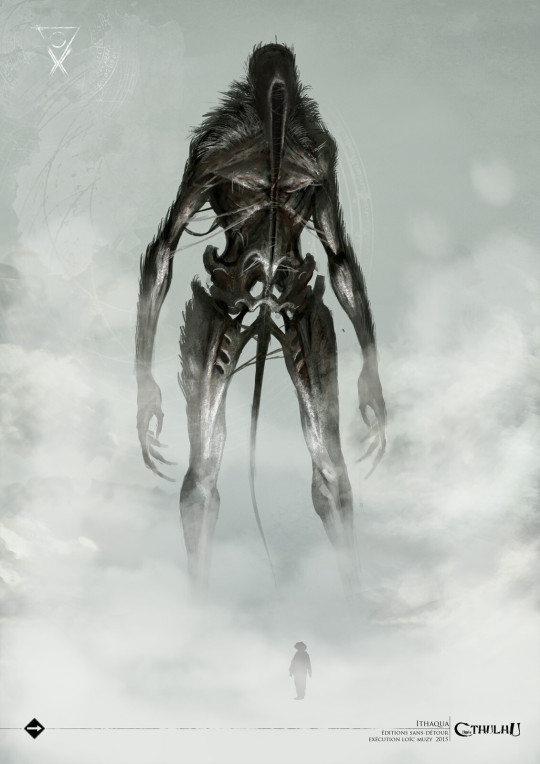
Image from a recent French edition of Call of Cthulhu RPG, by Loic Muzy
In Pet Sematary, Stephen King uses a wendigo as the reason for why the titular cemetery is cursed. This is an update of the classic racist trope of the “Indian Burial Ground”, except this time what gets buried there comes back animalistic and evil. The racist implications of that are pretty apparent. This wendigo is seen briefly and has ram’s horns. It does not appear in the first film adaptation, but does in the more recent one... with deer horns instead, because those are trendy right now.
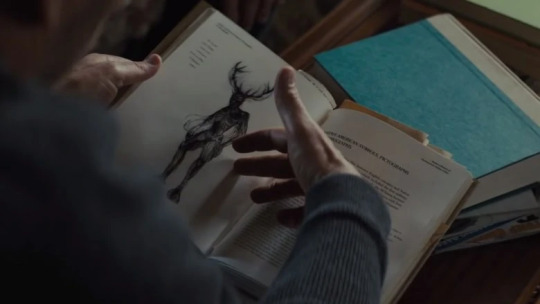
A good scholarly look at the real windigo versus the 20th century horror wendigo is “The Appropriation of the Windigo Spirit in Horror Literature” by Kallie Hunchman.
In the 1980s, a movie called Frostbiter: Wrath of the Wendigo was produced, but it wasn’t released until 1995 by Troma. From what I’ve read, it’s a pretty transparent ripoff of Evil Dead 2, with the characters being picked off in a haunted cabin with a zombie in the basement. The “twist” is that the origin of the horrors is a wendigo released by breaking a Christian demonology-style sacred circle. This wendigo is realized in stop motion animation, and has the most deer-like body yet.

A number of other independent horror movies in the 90s and 2000s used wendigos as a plot element. These follow the Blackwood/King approach of having the wendigo being something evil, ancient and Native American, reflecting white anxieties about living on stolen land more than Native anxieties about cannibalism and greed. Wendigo (2001) has the creature sicced on a white family when they hit a deer with their car. The Last Winter (2006) posits that global warming and fossil fuel extraction have unleashed the ghosts of dead animals, which are wendigo apparently, to revenge themselves on mankind. Which approaches the idea that greed is wendigo sickness, but I don’t think intentionally as a reference to modern Native literature. The “wendigo” in this movie are spectral moose and caribou.

The mainstream breakthrough of the deer-headed wendigo was in, appropriately enough for this blog, Pathfinder RPG. In “Spires of Xin-Shalast”, the last volume of Rise of the Runelords published in 2008, a wendigo is a major encounter. I suspect that either the author (Greg A. Vaughn), or one of the editorial staff had seen Frostbiter, as the setup involves a cabin haunted by dwarven cannibal ghosts who all killed and ate each other due to a wendigo’s influence. This wendigo is a hybrid of the Blackwood and Cree versions in terms of its MO: it is a cannibal ice spirit that wants to make more cannibals, and does so by abducting people and running off into the sky with them. Its design is the standard for what most Western artists depict wendigos as these days: an emaciated humanoid with the head and antlers of a deer (and the burned off feet of Algernon Blackwood, which are less common):
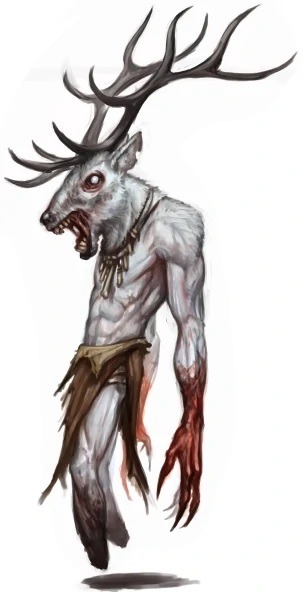
Image by Tyler Walpole, © Paizo Publishing
This wendigo definitely made a splash at the time; it was the first time I remember seeing a deer-headed wendigo, and art of that design started to become common. It pushed away previous wendigo depictions, which were typically werewolves (as French Canadian trappers had blended the concept with their own loup-garou, and Werewolf the Apocalypse had a whole faction of racist Native American “wendigos”) or shaggy and ape like (based more on the look of the Marvel Comics villain).
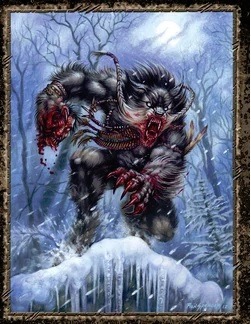
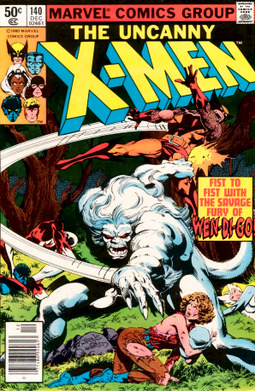
What turned wendigos from “folklore/horror monster” to “fandom blorbo” was Hannibal, which first aired in 2013. In that series, the first murder is a woman’s body impaled on a stag’s head, after which protagonist Will Graham has visions of a black stag, and a man with the antlers of a stag, representing murder, evil, and of course the cannibalistic murderer Hannibal Lecter.

Since Hannibal was super popular with the shipping fandom set, wendigo themed characters became popular in its wake, creating a wholly new way to culturally appropriate the wendigo. This was magnified by Over the Garden Wall, which came out in 2014, and its villain The Beast. The Beast is never called a wendigo, but is an antlered giant associated with winter, and so is commonly head-canoned as a wendigo and associated with them in fandom circles.

Which gets us to the modern day, where teenagers have misunderstood wendigo OCs, any character with antlers can be called a wendigo on the internet, and actual First Nations people with an actual cultural connection to the legend wish that people would just knock it off.
#and now you know#wendigo#windigo#witiko#creature design#art history#pathfinder rpg#algernon blackwood#august derleth#cthulhu mythos#stephen king#b movies#stop motion#hannibal#native american#first nations#cultural appropriation#long post
2K notes
·
View notes
Text

Ronald Clyne - Not Long for This World, 1948
#ronald clyne#not long for this world#cover art#august derleth#arkham house#horror art#graveyard#cemetery#art#illustration
179 notes
·
View notes
Text

SLEEP NO MORE (Panther, 1964)
#pulp#horror#pulp fiction#pulp horror#arkham horror#august derleth#lovecraft#horror books#60s horror#60s pulp#60s pulp horror#1960s horror#1960s pulp#halloween#happy halloweeeeeeen#all hallows eve#horror anthology#m r james#pulps#robert bloch#clark ashton smith#algernon blackwood#m p shiel
164 notes
·
View notes
Text
Midnight Pals: It's about ethics
Stephen King: oh boy this is embarrassing
Poe: what's that?
King: well, see, we kinda
King: accidentally
King: agreed to let this nazi a story
Poe: oh boy that is a pickle
King: yeah its a real whoopsie doodle
Poe: did we already tell him yes?
King: yeah
Poe: well criminy
Poe: not much we can do then
Poe: that'd be like going back on a pinkie swear
King: yeah it'd be like
King: kinda awkward
Poe: who was in charge of the paperwork
Poe: was it howard
David A Riley: Submitted for the approval of the Midnight Society, I call this the tale of the nazi supermen who are our superiors
Riley: look, i'm a big fan of howard there
Riley: not of his writing so much
Riley: mostly just his racism
Riley: what if some dusky kids turned into big scary monsters and killed a nice unassuming white person?
Riley: what about that??
Riley: [sitting on chair backwards] i know it sounds like science fiction but actually this scenario is playing out everyday right here in Britain
Riley: the blacks and the jews are going to make the full english breakfast illegal, you know
Lovecraft: i-is that true??
King: ok you've had enough for tonight howard
Riley: and let me tell you what the hoodie scum are doing to the soil
King: listen david some of these ideas are a little
King: umm
King: they're a little
Barker: they suck
Barker: they suck ass
King: yes thank you clive
King: i think that says it all, really
Riley: i am being silenced!
King: we really don't think we should have actual nazis here
Riley: YOU ALL SAID I COULD
Riley: oh oh now you're going back on your word!!!
Riley: you know what that is????
Riley: UNETHICAL
Riley: this is all about ethics in campfire storytelling
King: yeah i think we kinda goofed letting a nazi in
Riley: you let howard stay here
King: well, howard's just howard
King: he's a lovable archie bunker kinda racist
Lovecraft: it's true, i am
King: see the thing with howard is
August Derleth: I'LL tell you the thing with howard
Derleth: he is only as racist as the average man of his time
Derleth: he didn't, like, run for office as an actual National Front candidate
Derleth: [turning to audience] you can google that
Riley: wow, so apparently just because i'm a literal nazi who literally ran for office as a nazi candidate
Riley: who wants to eradicate asians and jews
Riley: suddenly I'm not welcome here?
Riley: wow
Riley: just wow
Riley: that's fine, i don't need you anyway
Riley: i'll always be welcome in the pages of the Magazine of Fantasy & Science Fiction
Barker: yeah you sure about that pal?
Barker: feel like that might be a mistake
Riley: NO
Riley: IT IS NOT A MISTAKE
Riley: SHUT UP
#midnight pals#the midnight society#midnight society#stephen king#clive barker#edgar allan poe#hp lovecraft#august derleth#david a riley
140 notes
·
View notes
Text




Four early-70s Ballantine paperbacks by and about H. P. Lovecraft, with wraparound cover art by Gervasio Gallardo.
#h. p. lovecraft#ballantine books#august derleth#lin carter#cthulhu#cthulhu mythos#paperback covers#weird fiction#gervasio gallardo
319 notes
·
View notes
Photo

Bruce Pennington’s 1974 cover to Trail of Cthulhu, by August Derleth
814 notes
·
View notes
Text
Hastur makes absolutely no since as a written being. It’s like a bunch of disparate entities were just strapped together at random. Hastur and The King in Yellow aren’t even the same thing? Then how did they get conflated? What’s with this octopus in Lake Hali? Why is there a sky chimpanzee? This an entity so broad that it’s become essentially generic. You could switch it out with the Judaeo-Christian Satan or Diablo or Skeletor for all that’s specific. What kind of idiot just wraps a bunch of different, unconnected stories together with the only through-line being ‘Lovecraft said he liked it once’?
Wait a second…
What’s that on the cover of Weird Tales?

AAAAAAAAAAAGGGGGGGHHHHHHH NOT AGAIN AAAAGGGHHH

82 notes
·
View notes
Note
what's wrong with derleth? Explain it to me like Idk anything, because I was under the impression he was the primary reason lovecraft's work survived as long as it did after his death
Sort of yes and sort of no.
Lovecraft wanted his estate to go to his friend, a young gay man and author named Robert Barlow, but August Derleth was an older cishet white man in the 30s and was like "lol no" and was a cunt about it and also wrecked Barlow's reputation.
It's true that Derleth founded Arkham House in order to publish Lovecraft's work, and ended up essentially preserving generations of weird fiction and pulps that would've otherwise been lost to time more or less single handedly, but he also meddled with Lovecraft's work and made edits that Sucked and his work wasn't restored until ST Joshi did the legwork in like the 90s for it.
He also did a LOT of anti-Native racism. They're all pretty guilty of it, but Derleth's is particularly egregious with the Tcho-Tcho (who should be thrown out completely) and Ithaqua (who needs a lot of work to be decoupled from the W*/ice cannibal from Algonquin/Aashinabe spirituality but is still imo salvageable)
He also, and this is more personal, just flat out sucked at writing.
97 notes
·
View notes
Text
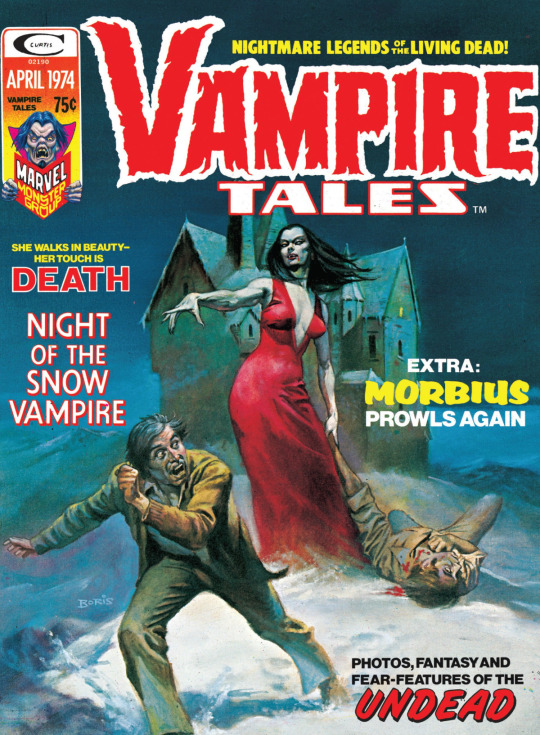
April 1974. The Boris Vallejo cover painting and "Night of the Snow Vampire" caption allude, somewhat vaguely, to this issue's adaptation by Tony Isabella of the 1939 August Derleth short story "The Drifting Snow," exquisitely drawn by Spanish artist Esteban Maroto:
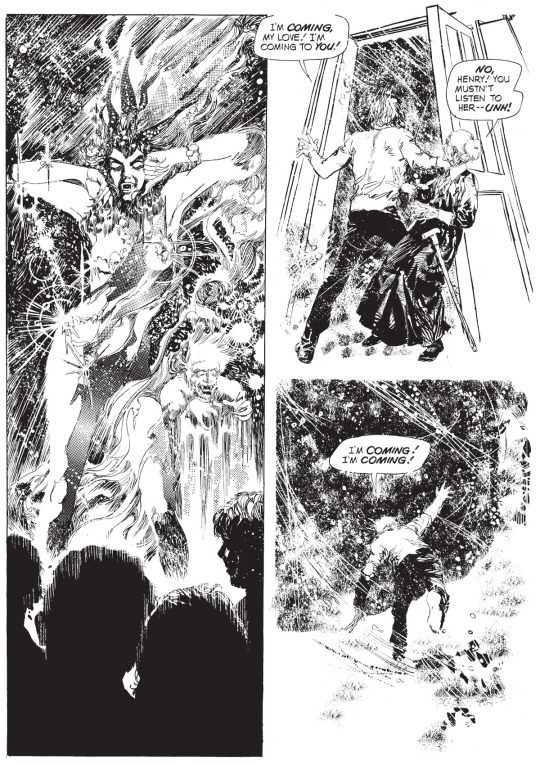
#comics#vampire tales#boris vallejo#tony isabella#esteban maroto#august derleth#the drifting snow#vampires#as always the morbius stories are a waste of time and paper
34 notes
·
View notes
Text

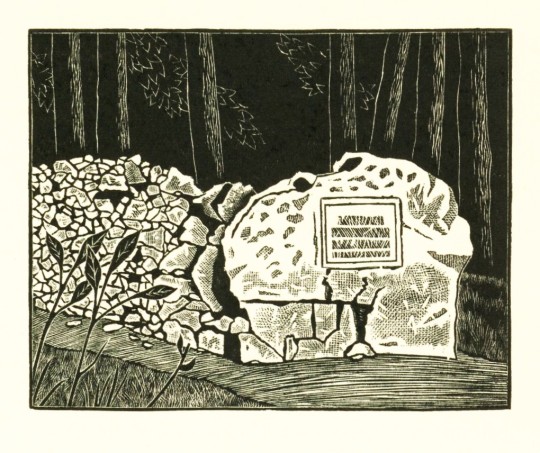

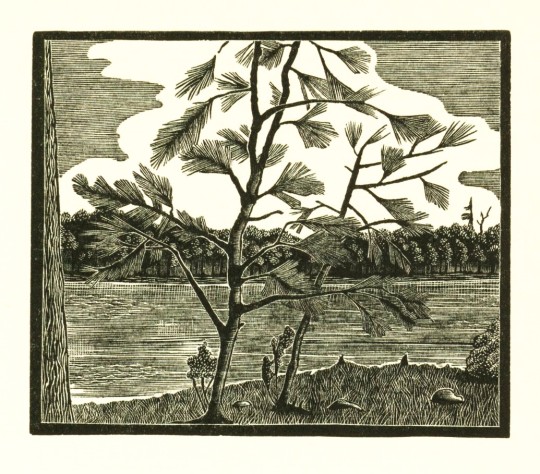
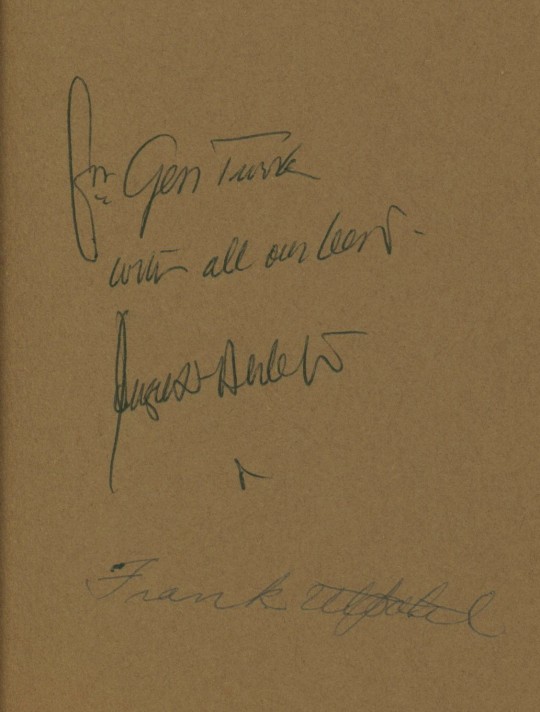
Wood Engraving Wednesday
Noted Wisconsin artist Frank Utpatel (1905-1980) was a longtime collaborator with Wisconsin writer and publisher August Derleth (1909-1971), who founded the Arkham House publishing firm in Sauk City, Wisconsin, publisher of, among other things, the works of H. P. Lovecraft. Many of Utpatel's book illustrations were done as wood engravings. Presented here are four engravings by Utpatel, printed directly from the original blocks for August Derleth's journal musings Walden Pond: Homage to Thoreau, and printed in 1968 by letterpress publisher Carroll Colman (1904-1989) at his Prairie Press in Iowa City, Iowa.
A Thoreau enthusiast, Derleth made three pilgrimages to Walden Pond in 1938, 1947, and 1965. This book presents some of his journal entries from those visits, "brought together here in the hope that fellow Thoreauvians may find something to their liking in these pages." Our copy was signed by Derleth and Utpatel to Wisconsin resident Genevieve Turk.

View more wood engravings by Frank Utpatel.
View more posts on works by August Derleth.
View more posts with wood engravings!
#Wood Engraving Wednesday#wood engravings#wood engravers#Wisconsin artists#Wisconsin writers#Frank Utpatel#August Derleth#Carroll Coleman#Prairie Press#Walden Pond: Homage to Thoreau#fine press publishing
31 notes
·
View notes
Text

Vintage Paperback - Beyond Time And Space by August Derleth
Berkley (c.1950)
#Paperback Cover#Paperback Art#Science Fiction#August Derleth#Beyond Time And Space#Rockets#Vintage#Art#Theodore Sturgeon#Robert Heinlein#Clark Ashton Smith#AE Van Vogt#Olaf Stapleton#Berkley#Berkley Books#1950s#50s#Paperback#Paperbacks
47 notes
·
View notes
Text
Lloigor
Another Call of Cthulhu monster!
~
Lloigor

Art by Christopher Burdett!
Your foe –unseen until now – warps space and bends light as a horrible form appears. At a glance, you could mistake it for a dragon. But it has too many eyes and limbs, and its mouth distends like its body is a sheath of reptilian skin.
In its most common form, a lloigor is invisible to conventional senses. Lloigors must alter their geometry to manipulate physical objects; in our visual spectrum, this condensed form resembles a grotesque pastiche of a dragon. Besides a similar shape, comparable strength, and humanoid-enslaving tendencies, these interstellar horrors have nothing in common with dragons.
Upon outgrowing (read: dominating and desiccating) their distant home sphere, the lloigors’ creator-god (also named Lloigor) taught its children the secrets of space travel. Since leaving home, the lloigors spread violent atrocities, empires based on fear and sacrifice, and countless people reshaped as wretched works of flesh-based art. A few great mages – of races that far predate modern humanoids – managed to craft symbols that drive away the lloigor scourge, symbols transmuted and cheapened over time into common glyph-based spells.
However, the lloigors did not realize their folly until they enjoyed several millennia of colonizing other planets. A connection to their deity and homeland was the source of their terrifying psychic prowess; ever since spreading across the universe, the lloigors’ powers were weakening. Only by consuming intelligent minds can lloigors recapture a fraction of their terrible power. After numerous rebellions, the humiliated lloigors retreated to the shadows and caverns of various worlds.
Lloigor
Small (vortex form)/large (reptilian form) Aberration, Lawful Evil
Armor Class 16 (many-angled)
Hit Points 161 (17d10 + 68)
Speed 30 ft. (reptilian form only), hover 30 ft. (vortex form only)
Vortex Form: STR 1(-5) DEX 16(+3) CON 19(+4) INT 21(+5) WIS 18(+4) CHA 18(+4)
Reptilian Form: STR 23(+6) DEX 16(+3) CON 19(+4) INT 21(+5) WIS 18(+4) CHA 18(+4)
Saving Throws Cha +8, Con +8
Skills Deception +8, Intimidation +8, Perception +8
Damage Resistances fire, nonmagic (Reptilian form), psychic (Reptilian form)
Damage Vulnerabilities radiant
Damage Immunities cold, force (Vortex form), nonmagic (Vortex form), psychic (Vortex form)
Condition Immunities charmed, frightened, frozen
Additional Immunities for Vortex Form blinded, deafened, grappled, poisoned, prone, restrained
Senses Darkvision 150 ft., passive Perception 18, truesight 120 ft.
Languages Common, Deep Speech, Draconic, Infernal, Undercommon
Challenge 11 (7,200 XP)
Proficiency Bonus +4
-
Innate Spellcasting. The lloigor's innate spellcasting ability is Intelligence (spell save DC 17, +9 to hit with spell attacks). It can innately cast the following spells, requiring no components. However, it does need to expend Leeched Mental Energy (LME, from here on). Assume any lloigor has 4d6 stored LME at the start of an encounter.
Free Spells: gust, mage hand (hand is invisible), mind sliver (3d6)
2-point Spells: catapult
3-point Spells: detect thoughts, dissonant whispers (level 2), gust of wind, mind spike, misty step
5-point Spells: fireball, sending, slow, wind wall
6-point Spells: confusion, dimension door, polymorph, Raulothim's psychic lance
7-point Spells: Bigby’s hand (hand is invisible), control winds, create spelljamming helm, telekinesis
Bound by the Signs. Certain timeless sigils can repel the lloigor and its depraved magicks.
If a lloigor damages any creature protected by warding bond, the lloigor takes the caster’s share of the damage.
The lloigor takes maximum damage from glyph of warding.
Death ward heals all effects (except damage) from the lloigor’s fleshwarping – even regenerating severed limbs.
A lloigor can’t even attempt to enter any area protected by guards and wards, even by teleportation.
Deadly Pessimism. Lloigors’ minds are endless wells of hatred and pessimism – too much for even the most spiteful mortal mind-reader to bear. Any creature that tries to read a lloigor’s thoughts is subject to a DC 17 Wisdom saving throw.
Success: The mind-reader escapes the abyss of the lloigor’s thoughts with nothing but a searing headache. For 1 minute, the mind-reader rolls Intelligence, Wisdom, and Charisma checks with disadvantage since it hurts to concentrate.
Failure: The mind-reader is afflicted with short-term madness.
Failure by 10 or More: The mind-reader is afflicted with long-term madness.
Critical Failure: The mind-reader dies.
Legendary Resistance (3/Day). If the lloigor fails a saving throw, it can choose to succeed instead.
Star-Treader. The lloigor doesn’t need to breathe, and it can shrug off extreme cold (included in stat block).
Actions
Multiattack. In its reptilian form, the lloigor makes one Bite attack and two Claw attacks. The lloigor has no physical attack options in vortex form.
Bite (Reptilian Form only). Melee Attack: +10 to hit, reach 5 ft., 1 target. Hit: 12 (1d12 + 6) piercing damage.
Claw (Reptilian Form only). Melee Attack: +10 to hit, reach 5 ft., 1 target. Hit: 10 (1d8 + 6) slashing damage.
Fleshwarp (Recharge 5-6). In reptilian form, the lloigor must touch its target. A lloigor in vortex form can attempt to warp any target within 60 ft. Targets make a DC 16 Constitution save as their own bodies twist and rebel. On a failure, the target takes 8d10 necrotic damage, and one of their features are bent to the lloigor’s whims – a limb, torso, neck, head shape, or facial feature. On a success, the target takes half damage, and no transformation occurs. On a critical failure, the lloigor gains enough control over the flesh to exact one of their favorite punishments: shriveling limbs. The target loses the use of an arm or leg (DM’s choice).
Reversing the lloigor’s fleshwarping requires casting remove curse or greater restoration at level 6 – or, curiously, a regular 4th-level casting of death ward.
Bonus Actions
Condense/Refract. The lloigor changes between Vortex and Reptilian form. If a lloigor changes into its reptilian form thirty feet or more off the ground, it is subject to fall damage.
Reactions
Feed on Anguish. When a lloigor deals damage to another creature, the lloigor can use its reaction to regain 1d4 LME.
Legendary Actions
The lloigor can take 3 legendary actions, choosing from the options below. Only one legendary action can be used at a time and only at the end of another creature's turn. The lloigor regains spent legendary actions at the start of its turn.
Attack. The lloigor makes one Bite or two Claw attacks.
Cast a Spell (Costs 3 Actions). The lloigor casts one of its spells, using the normal amount of LME.
Recalculate. The lloigor attempts to recharge its Fleshwarp ability.
Lair Actions
On initiative count 20 (losing initiative ties), the lloigor can take one of the following lair actions; the lloigor can't take the same lair action two rounds in a row:
Psychic Vampirism. The lloigor targets a random sleeping humanoid within 6 miles of its lair. The target loses 1d4 Intelligence, Wisdom, or Charisma (lloigor’s choice), and the lloigor gains an equal amount of LME. The target suffers a level of exhaustion all the next day, but another long rest will cure both the exhaustion and the ability loss. The target only dies if the ability damage reduces that ability to 0.
Summon Prey. The lloigor chooses any living mortal creature in the universe. The target makes a DC 16 Wisdom saving throw. On a success, the target is summoned to a random point within 1 mile of the lloigor. On a failure, the prey is teleported within 100 feet of the lloigor.
Warp Time. The lloigor must also spend the rest of its stored LME to use this lair action. Every creature in the lair must reroll initiative. The lloigor can choose not to reroll.
Regional Effects
The region surrounding a lloigor's lair is altered by the lloigor's magic, creating one or more of the following effects:
For 6 miles around the lloigor’s lair, people tend to act uncharacteristically dour and negative.
Long-term exposure to the lloigor’s presence stains water and stone a jade tint. This jade stain is only visible if the lloigor’s been around for over a year, and the unnatural color is more noticeable as you approach the lair. Although a gorgeous color, looking at these lloigor-changed features instills nausea, as if the earth itself is warning you to turn back.
The lloigor practices its fleshwarping on local wildlife. Many beasts within 6 miles of the lair bear grotesque mutations.
If the lloigor dies, the mood-altering effect vanishes immediately. The other effects are, unfortunately, permanent.
~
DESIGN NOTES
I know in RAW you can’t cast remove curse or greater restoration at higher levels – but why not? I don’t think you should be able to remove a high-level monster’s debilitating curse with a level 3 spell in every healer’s back pocket.
#Call of Cthulhu#Cthulhu mythos#August Derleth#Colin Wilson#homebrew monster#D&D monster#aberration#CR 11#stat block#lovecraft monster
49 notes
·
View notes
Text

Boris Dolgov - Saunder's Little Friend
(Weird Tales - May 1948)
#boris dolgov#saunder's little friend#august derleth#weird tales#horror art#pulp art#imp#art#illustration
180 notes
·
View notes
Text
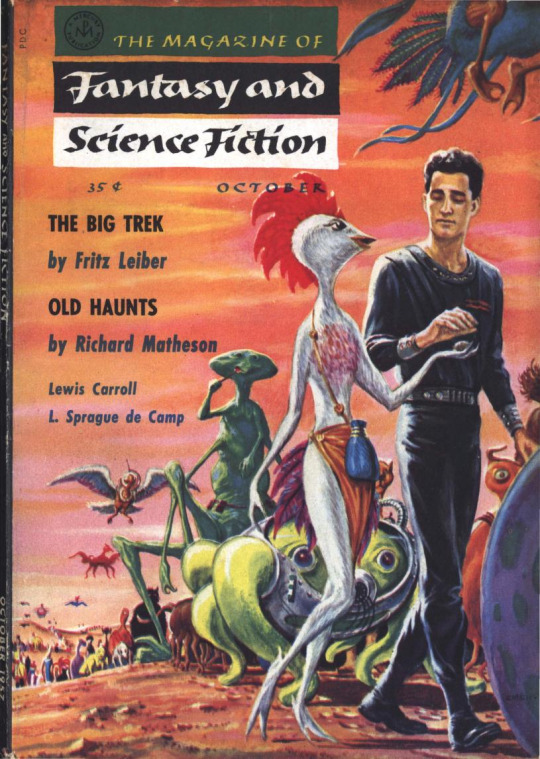
FANTASY AND SCIENCE FICTION Vol. 13 #4 (Fantasy House, 1957)
Art: "EMSH" (?)
Edit: thanks to @jamie-b-good who reckons EMSH is likely to be Ed Emshwiller. Dang, that one was staring me in the face lol Thanks, Jamie!
#pulp science fiction#science fiction#sci fi#sci fi art#pulp sci fi#fantasy#50s science fiction#50s sci fi#50s pulp#1950s pulps#1950s pulp#1950s sci fi#1950s science fiction#aliens#fritz leiber#l sprague de camp#august derleth#richard matheson#alien
237 notes
·
View notes
Text
Midnight Pals: Penguins on Parade
Edgar Allan Poe: i feel like there's been way too much drama here lately
Poe: too many cranks just venting obsessions and paranoias!
Poe: can't we just hear a nice, simple, old-fashioned horror story?
HP Lovecraft: i-i've got one
Poe: ...son of a bitch
Poe: ok howard let's hear it
August Derleth: wooo! yeah!
Derleth: go off Howard, you got this!
Lovecraft: y-yeah ok
Derleth: a-grade storytelling, right here! modern master!
Lovecraft: a premise occurred to me one night while in the throes of fitful sleep
Derleth: yes! yes! tossing and turning! sweat that plot out
Lovecraft: about an ill-fated expedition to the Antarctic
Derleth: cold as ice! chilly like my willy, baby
Lovecraft: p-please stop
Poe: ah, the South Pole Poe: a promising location for a doomed voyage
Poe: not to spoil anything but
Poe: they all drown in the magnetic whirlpool, right?
Lovecraft:
Poe: that resides at the bottom of the world, right?
Lovecraft:
Poe: perhaps they're slaughtered by hostile peoples of the inner earth?
Lovecraft: n...
Lovecraft: no, there's a continent there
Poe: oh, a fantasy story? fun!
Lovecraft: even the beginning of this terrible journey is fraught with peril
Lovecraft: for they must encounter that most loathsome of all birds
Lovecraft: THE PENGUIN
Clive Barker:
Barker: ah ha ha
Barker: oh man
Barker: let's fucking go, curtain up
Dean Koontz: i like penguins :)
Koontz: stephen let me watch happy feet
Koontz: it was funny
Koontz: except for the seal
Stephen King: we had to fast-forward past the seal
King: and the orcas
King: pretty much the entire second half
Koontz: i like when they dance
Lovecraft: b-but these are no ordinary penguins
Lovecraft: the average penguin is black AND white
Lovecraft: a hideous mixture in itself
Lovecraft: yet these massive creatures are ALBINO
Lovecraft: so pale as to be mistaken for snowdrifts at a distance
Lovecraft: you might say they are passing for white
Poe: uhh
Derleth: shhh, let him cook
Lovecraft: t-the group found a perplexing frozen specimen
Lovecraft: i-it was only when they discovered the ruins later that they realized it was a being of great intelligence
Lovecraft: for, you see
Lovecraft: the thing had no skull to measure
Lovecraft: millions of years ago, the Old Ones flourished upon the continent
Lovecraft: they built a society dedicated to pure scientific achievement
Lovecraft: yet, in the cruelest irony
Lovecraft: they were overwhelmed by sheer brute strength
Barker: lol
Barker: get owned nerds
Lovecraft: i-it was a most grand civilization
Lovecraft: accomplished universities. safe to slither the streets at night
Lovecraft: and then a certain kind of creature
Lovecraft: i shall not say whom
Lovecraft: took over
Lovecraft: and the property values... they plummeted
Derleth: okay look i'm getting a little sick of all of you calling Howard a bigot
Derleth: i keep telling you he's simply a man of his time
Lovecraft: the shoggoths were faceless slaves of the deepest black hue
Lovecraft: possessing a fiendish malevolence to compensate for their lack of a brain
Derleth:
Derleth: oh and i suppose you're just going to take THAT out of context
Lovecraft: most chilling of all the shoggoths' attributes was their infernal piping
Lovecraft: it imitated the structure of the Old Ones' music
Lovecraft: but it was as if they spoke rather than harmonized it
Lovecraft: and inserted coarse references to anatomy
Lovecraft: there were indeed some horrors in this house
Lovecraft: and they were wet and gushy
Lovecraft: no bucket or mop would suffice
Lovecraft: they escaped with their lives, yet Danford was tormented by visions of the shoggoth unto madness
Lovecraft: for knowledge of the unknown has a terrible price, and death and ignorance are our only mercies
Lovecraft: the end
Derleth:
Barker:
Poe:
Koontz:
King:
King: so, Dean, I have this DVD of Norm of the North
John W. Campbell: say, that's a pretty good yarn, but couldn't more happen with the shapeshifting
Campbell: what if the shoggoth was able to fully mimic its human prey
Lovecraft: fully ASSIMILATED among men?
Lovecraft: there is cosmic horror, sir, and then there is simply bad taste
Thanks to guest writer my pal Morbiose for help with this thread!
#midnight pals#midnight society#the midnight society#hp lovecraft#clive barker#edgar allan poe#stephen king#dean koontz#august derleth#joseph w campbell
138 notes
·
View notes
Text
Since Richard Tierney wrote his brief but landmark essay, "THE DERLETH MYTHOS" there has been an ever growing trend to attack August Derleth for the mistakes he made in interpreting Lovecraft's fictional intentions. As I've mentioned before Derleth had to work fast to take control of Lovecraft's legacy. He was probably unaware - at least imeadiateIy after HPL's death - that Lovecraft had chosen Robert Barlow to be his executor in case of his passing. Some have suggested that Derleth and others of the 'Lovecraft Circle' had conspired against Barlow because he was homosexual. Barlow, however, was not open about his sexual orientation and those days were FAR more restrictive about such issues. In the letters that passed between August Derleth and Clark Ashton Smith - the two men never met in person - Derleth mentioned how and why he decided to create ARKHAM HOUSE PUBLISHERS with Donald Wandrei - also a one time correspondent of Lovecraft's. The fact is that Derleth and his pals could not get any other established publishing house to print a book of Lovecraft's fiction. As a result they decided to take on the task themselves. Arkham House started with the fabled hardback " THE OUTSIDER AND OTHERS printed in 1939 (2 years after Lovecraft's death). Eventually Arkham House would publish 5 volumes of Lovecraft's SELECTED LETTERS. There has been some criticism of these books by those who have discovered numerous typos. However, in letters to Clark Ashton Smith - who would eventually see much of his own works published by ARKHAM HOUSE - Derleth admitted that he had hired a lady to transcribe Lovecraft's collected letters. In fact very few of Lovecraft's letters were typed. HPL hated using a typewriter and his handwriting was tiny, scrawling and some words could certainly be misinterpreted. Well, August Derleth was not perfect but he certainly achieved an enormous amount of good where promoting Lovecraft's legacy was concerned. Since Derleth's death on July 4, 1971 a great deal of new information has come out on Lovecraft, information that Derleth himself was not privy to. Derleth took a great risk and invested a considerable amount of his own time and money on behalf of Lovecraft's legacy. He may have made mistakes but his intentions were always good. He respected Lovecraft and his work sincerely. Something to consider as the legacy of H. P. Lovecraft progresses in the coming years. Below is a sample of one of Lovecraft's letters. The upper and lower right-hand pictures include photos of August W. Derleth. (Exhibit 469)


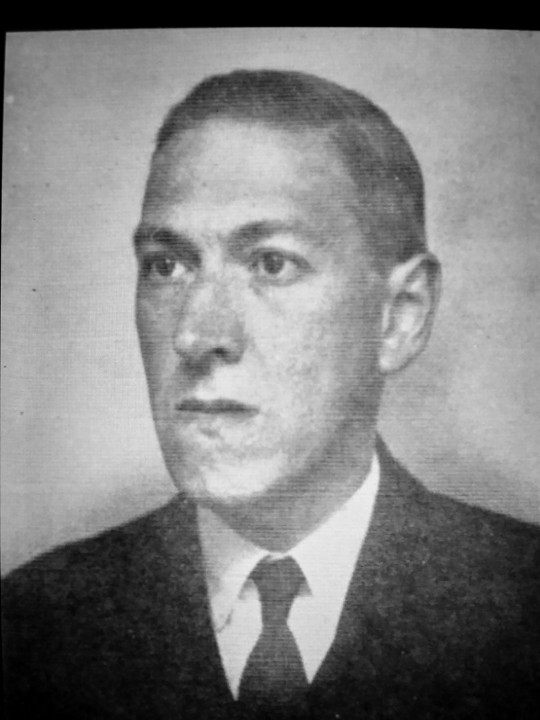

5 notes
·
View notes